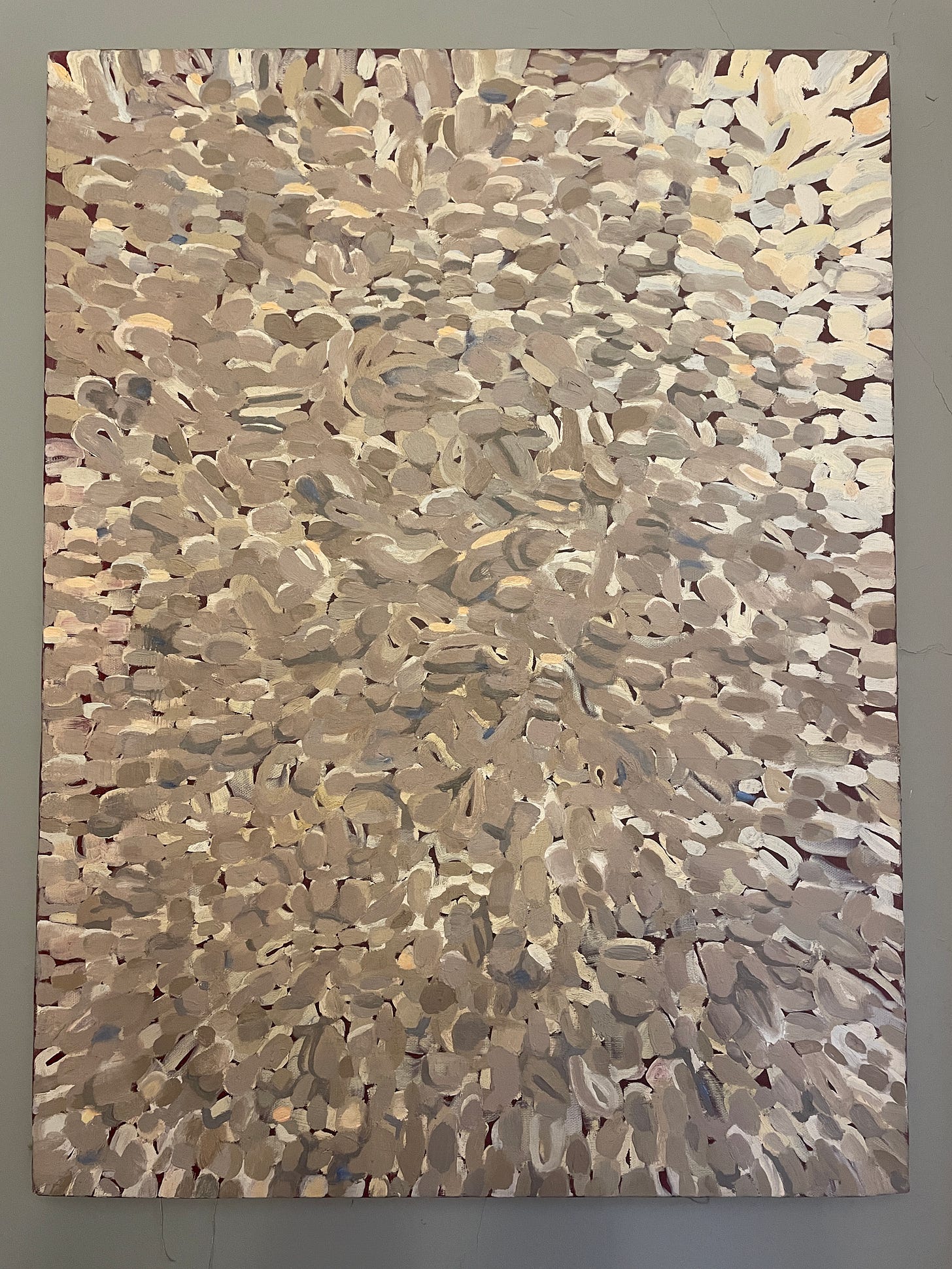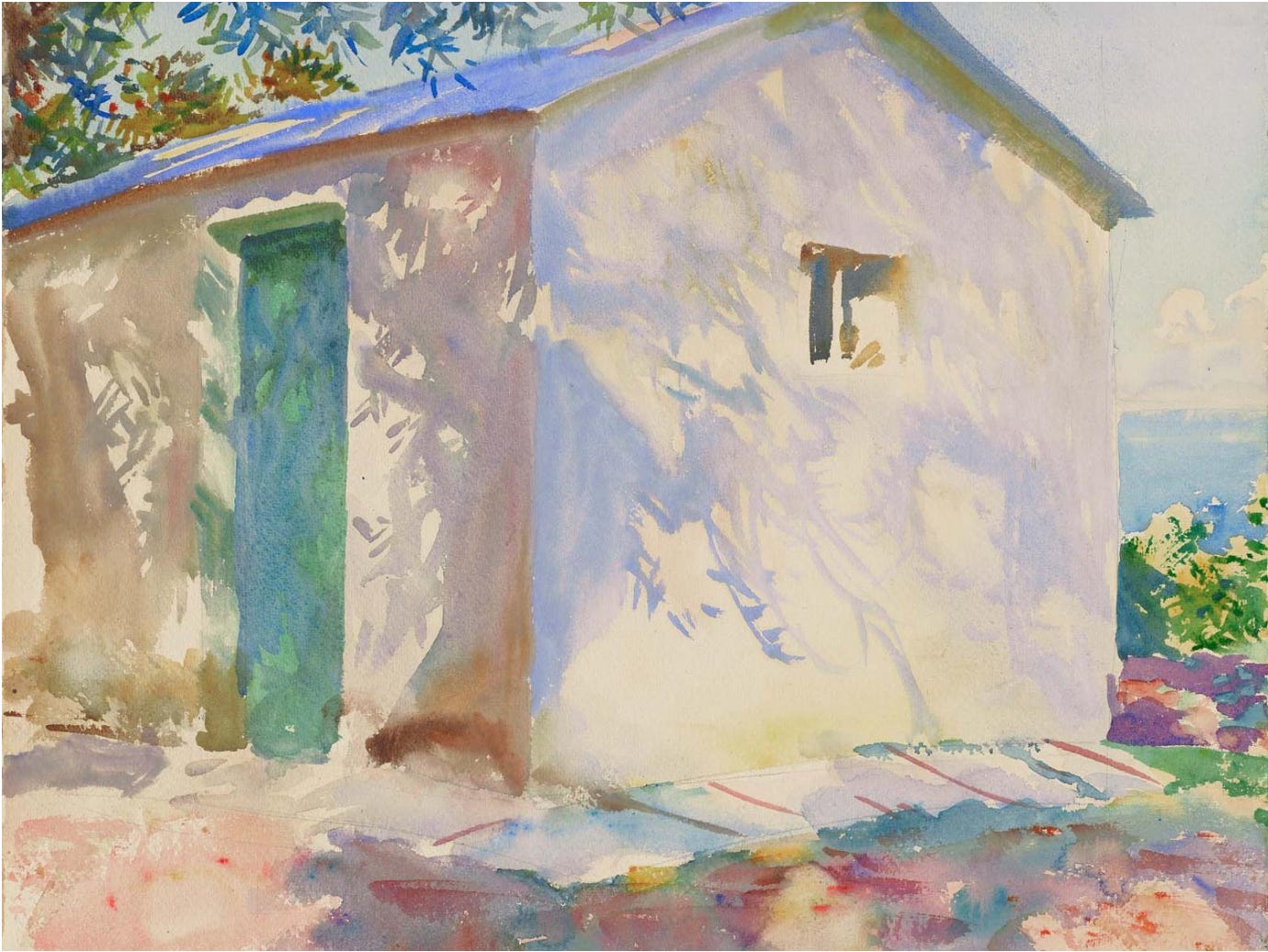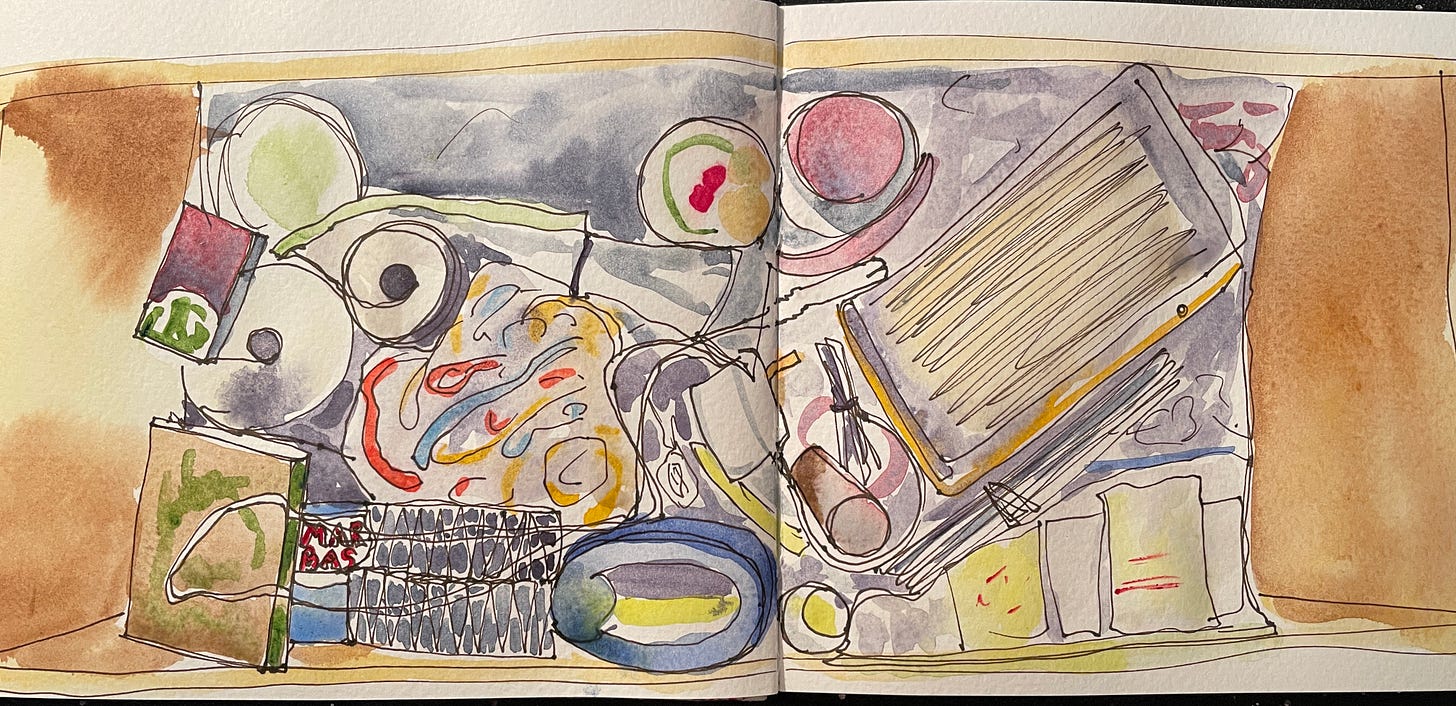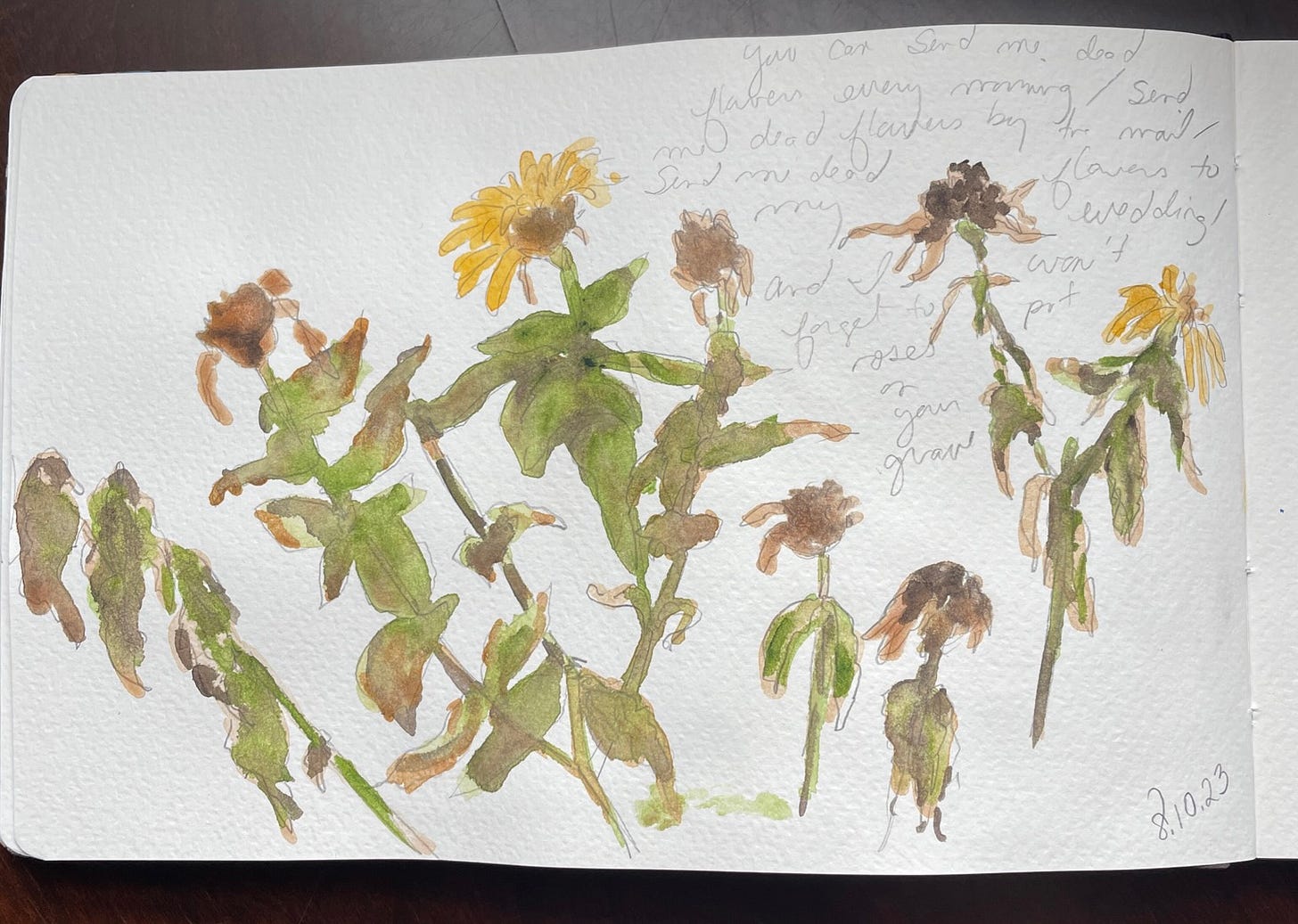Vol 3. The Problem with Pretty
In this post, some thoughts about loosening up, a sketchbook prompt to help you get past the fear of making "ugly" art, and a podcast recommendation.
Before we get into today’s post, an announcement: I am excited to share that I’ll be offering a selection of paintings for sale this fall. Members of the Paint Wasters’ Club will have access to my shop beginning October 1. It will open publicly on October 15. Stay tuned!
Musings: What’s wrong with pretty?
In my bathroom, I have a painting made by a friend. It is a medium-sized canvas with splotches of grays and pinks. When my husband and I were helping her clear out her apartment to get ready to move, she was going to throw it away. My husband took one look and said we’d take it.
Our friend said that once we knew what it was, we wouldn’t want it. She explained that she had made it as an assignment for an art class in college. The assignment was to paint a close-up view of something disgusting. We were baffled. To us, it was simply an abstract painting with a nice, soothing color palette.
No, our friend said. It was a painting of the bath mat in the apartment she had shared with several other students. It was gross because no one ever washed it. Whenever she looked at the painting, she thought of that dirty old thing and cringed.
Coincidentally the colors in the painting perfectly matched our rather 1960s bathroom, so we took it home and hung it up on the wall above the commode to cover up a wonky patch of old horse-hair plaster. No one who sees the painting knows what the artist was depicting, but we know its bathroom placement is entirely fitting, and despite knowing what our friend was painting, we like it!
I think the instructor’s assignment was ingenious, as it forced students to move past the impulse to seek out beautiful subject matter—I do think most of us tend to gravitate towards beauty, at least as beginners—and instead to create something interesting out of something disgusting.
There’s nothing wrong with seeking out beauty, but the problem with making beauty the number-one goal of a painting is that it creates a lot of pressure, and pressure makes you tense up, and tense people make tight, controlled, overworked paintings that, at best, appear overly studied and more often turn out lifeless or juvenile. I speak from loads of first-hand experience.
There’s that old adage, all art is self-portrait. I look at my first watercolor paintings and I think there’s some hard truth in that statement. I was trying so hard to make them just right, to be pretty. I desperately wanted people to see them and say, “That’s so good! You did that?” And when I take an honest look at myself, I can say that I am like that in life, too. I am a perfectionist. I want people to like me. I want to impress them.
And, of course, I want to be pretty, too. I have a lifelong fear of showing up in the wrong clothes, the wrong makeup, the wrong hairstyle. I have been sucking in my stomach more or less continuously since I was about ten years old for fear of appearing fat. Obviously, it’s a natural human tendency to want others to find one attractive, but when concern about one’s appearance becomes so prevalent as to make it hard to enjoy life for all that anxiety and fear and self-doubt, it’s a problem.
People probably don’t think of me as someone who is so worried about her appearance. I have short, no-nonsense hair, I almost never wear makeup, and I prefer sensible shoes and comfortable clothing. Now, in my mid-forties, I don’t obsess like I used to because I’ve done the work to realize I am fine just as I am. I long ago realized my appearance is not the most important or interesting thing about me.
Still, I have to consciously work to shut down the little voice in my head that says I’m not attractive enough or thin enough. I have plenty of moments of lapsing back into old thought patterns. We had family portraits done this summer, and I had an existential crisis over what to wear. I wanted to look like me, but, you know, a better, prettier, skinnier me.
Those old, deeply ingrained tendencies are there in those first paintings, too. That fear of not being perfect, of not being liked, the need to be pretty.
When I first got back into art, I made a lot of hand-painted cards for people. Cards were a good vehicle for my paintings because they were an easy way to give away art to loved ones who could either keep them and treasure them (fridge art!) or throw them away without much guilt because they were only cards. Also, sweetly pretty subject matter is appropriate on a card. I could have gone on making sweet paintings of teapots and flowers forever, except what I was making quickly stopped exciting me. The cards were cute, but they were also sort of boring. Even my loosest flowers were still tight and careful. They were pretty enough, but they were empty.

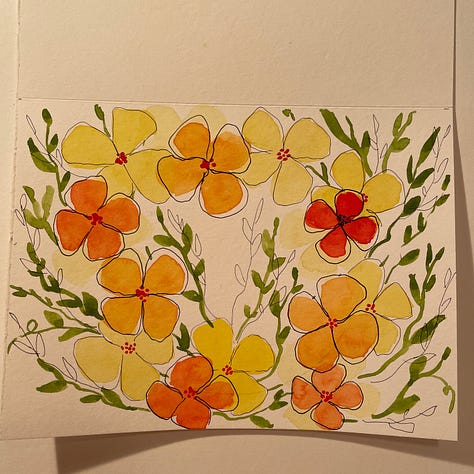
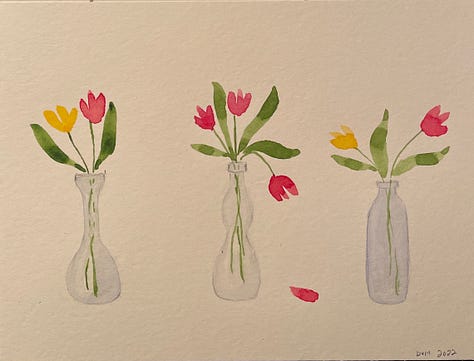
The art I most liked to look at wasn’t tight and restrained. I admired loose, impressionistic landscapes with lots of atmosphere and a sense of spontaneity and vibrancy. I didn’t want to paint endless wreaths of pretty little flowers. I wanted to paint scenes that invited the viewer in. I wanted to paint like John Singer Sargent and Winslow Homer and Edward Hopper! (I know, I know, lofty ambitions, but what are ambitions for, if not to be lofty?)
When I tried to imitate their styles, however, I felt full of anxiety and fear and self-doubt. What if I made mistakes? What if it didn’t come out pretty? What if my husband (the primary and often only viewer of most of my paintings) didn’t like it? What if I wasn’t a good enough painter? What if I would never be a good enough painter?
Just as I had to overcome anxiety and fear and self-doubt about my appearance so I could enjoy my life, I had to overcome anxiety and fear and self-doubt about painting so I could continue to find satisfaction in my art practice. I’m not done yet, of course. I have to work continually to push aside those negative emotions and grow as an artist.
Like any thought pattern one wants to change, I had to consciously alter my self-talk. Creating my motto helped (see Vol. 2) helped immensely. Now when I enter my studio, instead of telling myself I am Making a Painting, a Work of Art, I tell myself I am experimenting to see what will happen. I remind myself that paint and paper will be wasted in the process of making art. I remind myself that if this one doesn’t work out, there’s always more paint and more paper waiting for me tomorrow.

By shifting my thinking and therefore my approach to painting, my work has changed a lot. What I have come to understand is that to create landscapes that feel both true to the places that inspired them and have a sense of lively spontaneity, you need a huge amount of skill. You have to make a lot of bad paintings to make a few good ones. And to be okay with making bad paintings, you can’t be obsessed with creating beautiful results.
When I first got back into painting, if I made something and my hubby looked at it and said, “So pretty,” I was pleased. Now if he says that I know I haven’t been bold enough. I don’t want to paint pretty. I want to paint interesting.
Sketchbook Prompt
You may have already anticipated today’s prompt from my musings above. Today, I am going to challenge you to paint or draw something that you consider ugly. I am not going to go as far as asking you to paint something disgusting but look around your house for something you find to be an eyesore. Maybe it’s those nasty old sneakers you know you should throw away but you can’t seem to let go of. Maybe it’s the contents of your junk drawer. The trash bins at the curb. Dead flowers. Dirty dishes piling up by the sink.
Whatever you choose, study it closely. Freed from the impulse to make a pretty painting or drawing—your subject matter isn’t pretty, so it wouldn’t make a ton of sense for your artwork to be!—instead you can focus on shapes and colors. Study the thing closely until it practically dissolves itself into abstraction. And instead of making it pretty, see how interesting it can be.
Here are a few of my sketches of “ugly” subjects:
If you try this prompt, please share in the comments to tell me how it went! What did you choose for your subject? Did you have any surprises as you drew or painted it?
Podcast Recommendation
If you’re looking for something to listen to while you work on today’s prompt, check out the Artists for Joy Podcast. The host, Merideth Hite Estevez, is a musician on a mission to debunk the tortured artist stereotype. I love Merideth’s meditations on art and life and her practical advice for overcoming the obstacles we put in our own paths. I also love the musical interludes she puts between segments, and I often put on her Spotify playlists of music from the show when I’m painting.
If you enjoyed today’s post, please subscribe so you never miss an update!



